Rapid Transfer Alignment of MEMS SINS Based on Adaptive Incremental Kalman Filter
Abstract
:1. Introduction
2. Model of SINS Transfer Alignment
2.1. SINS Mechanized Arrangement
2.2. SINS Error Model
2.3. Flexural Deflection Error Model
2.4. State and Measurement Equations of the Transfer Alignment
3. The Improved Adaptive Incremental Kalman Transfer Alignment Algorithm
3.1. The Adaptive Kalman Filter (AKF)
3.2. The Adaptive Incremental Kalman Filter (AIKF)
3.3. Comparison of AKF and AIKF
4. Simulation Test and Results
5. Conclusions
Acknowledgments
Author Contributions
Conflicts of Interest
References
- Yuksel, Y.; El-Sheimy, N.; Noureldin, A. Error modeling and characterization of environmental effects for low cost inertial MEMS units. In Proceedings of the 2010 IEEE/ION Position Location and Navigation Symposium (PLANS), Indian Wells, CA, USA, 4–6 May 2010; pp. 598–612.
- Liu, M.; Gao, Y.; Li, G.; Guang, X.; Li, S. An Improved Alignment Method for the Strapdown Inertial Navigation System (SINS). Sensors 2016, 16, 621. [Google Scholar] [CrossRef] [PubMed]
- Sahawneh, L.; Jarrah, M. Development and calibration of low cost MEMS IMU for UAV applications. In Proceedings of the 5th International Symposium on Mechatronics and Its Applications, Amman, Jordan, 27–29 May 2008; pp. 1–9.
- Niu, X.; Li, Y.; Zhang, H.; Wang, Q.; Ban, Y. Fast thermal calibration of low-grade inertial sensors and inertial measurement units. Sensors 2013, 13, 12192–12217. [Google Scholar] [CrossRef] [PubMed]
- Lu, Y.; Cheng, X. Random misalignment and lever arm vector online estimation in shipborne aircraft transfer alignment. Measurement 2014, 47, 756–764. [Google Scholar] [CrossRef]
- Wu, Z.; Wang, Y.; Zhu, X. Application of Nonlinear H∞ Filtering Algorithm for Initial Alignment of the Missile-borne SINS. AASRI Procedia 2014, 9, 99–106. [Google Scholar] [CrossRef]
- Sun, J.; Xu, X.S.; Liu, Y.T.; Zhang, T.; Li, Y. Initial Alignment of Large Azimuth Misalignment Angles in SINS Based on Adaptive UPF. Sensors 2015, 15, 21807–21823. [Google Scholar] [CrossRef] [PubMed]
- Gao, S.; Wei, W.; Zhong, Y.; Feng, Z. Rapid alignment method based on local observability analysis for strapdown inertial navigation system. Acta Astronaut. 2014, 94, 790–798. [Google Scholar] [CrossRef]
- Gao, W.; Miao, L.; Ni, M. Multiple Fading Factors Kalman Filter for SINS Static Alignment Application. Chin. J. Aeronaut. 2011, 24, 476–483. [Google Scholar] [CrossRef]
- Ali, J.; Ushaq, M. A consistent and robust Kalman filter design for in-motion alignment of inertial navigation system. Measurement 2009, 42, 577–582. [Google Scholar] [CrossRef]
- Titterton, D.H.; Weston, J.L. Strapdown Inertial Navigation Technology, 2nd ed.; American Institute of Aeronautics and Astronomy Press: Reston, VA, USA, 2004. [Google Scholar]
- Groves, P.D. Principles of GNSS, Inertial, and Multisensor Integrated Navigation Systems; Artech House: London, UK, 2013. [Google Scholar]
- Gong, X.; Fan, W.; Fang, J. An innovational transfer alignment method based on parameter identification UKF for airborne distributed POS. Measurement 2014, 58, 103–114. [Google Scholar] [CrossRef]
- Kain, J.E.; Cloutier, J.R. Rapid Transfer Alignment for Tactical Weapon Applications. In Proceedings of the AIAA Guidance, Navigation and Control Conference, Boston, MA, USA, 14–16 August 1989; pp. 1290–1330.
- Ma, Y.; Fang, J.; Li, J. Accurate estimation of lever arm in SINS/GPS integration by smoothing methods. Measurement 2014, 48, 119–127. [Google Scholar] [CrossRef]
- Jwo, D.J.; Weng, T.P. An adaptive sensor fusion method with applications in integrated navigation. J. Navig. 2008, 61, 705–721. [Google Scholar] [CrossRef]
- Husa, I. Adaptive filtering with unknown prior statistics. In Proceedings of the Joint Automatic Control Conference, Boulder, CO, USA, 5–7 August 1969.
- Yang, Y.; Xu, T. An Adaptive Kalman Filter Based on Sage Windowing Weights and Variance Components. J. Navig. 2003, 56, 231–240. [Google Scholar] [CrossRef]
- Ding, W.; Wang, J.; Rizos, C.; Kinlyside, D. Improving adaptive Kalman estimation in GPS/INS integration. J. Navig. 2007, 60, 517–529. [Google Scholar] [CrossRef]


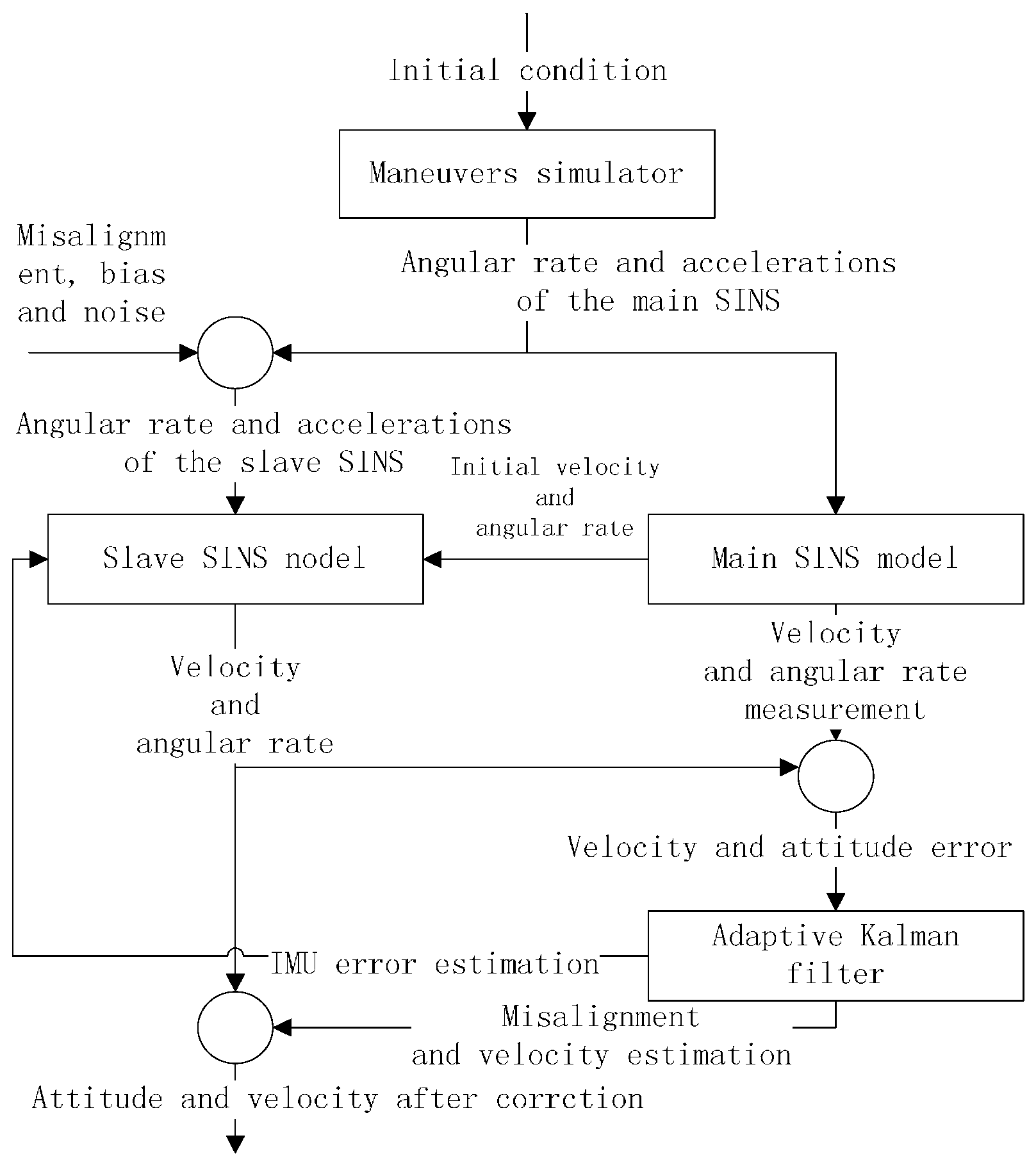
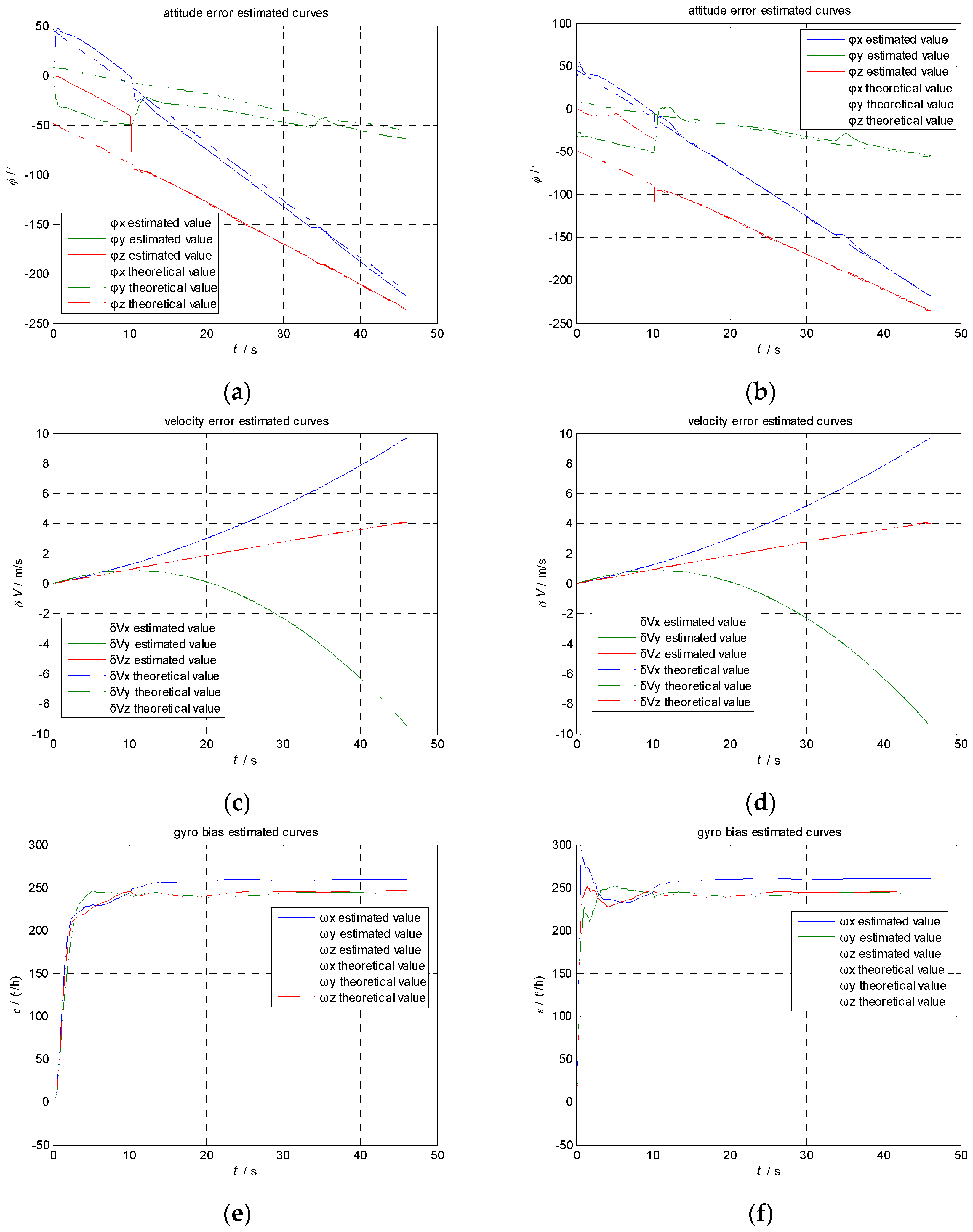
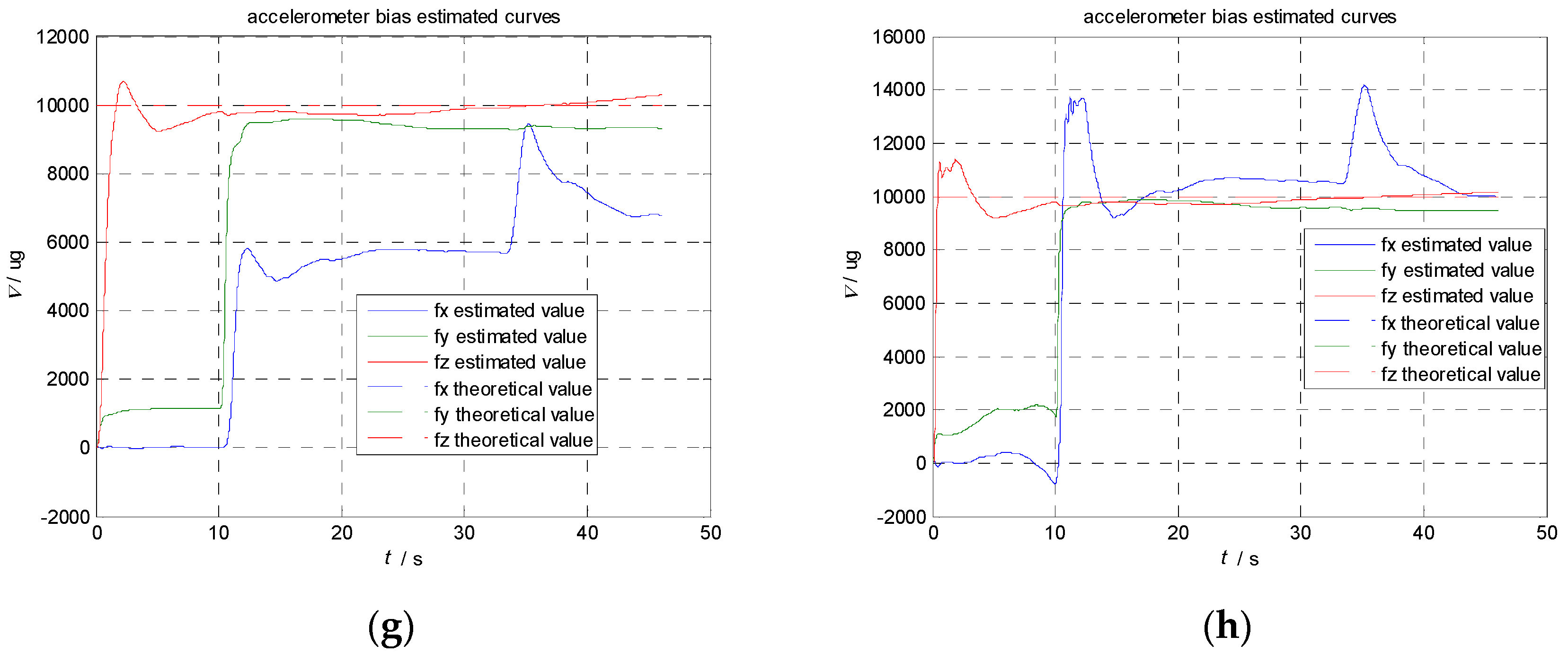

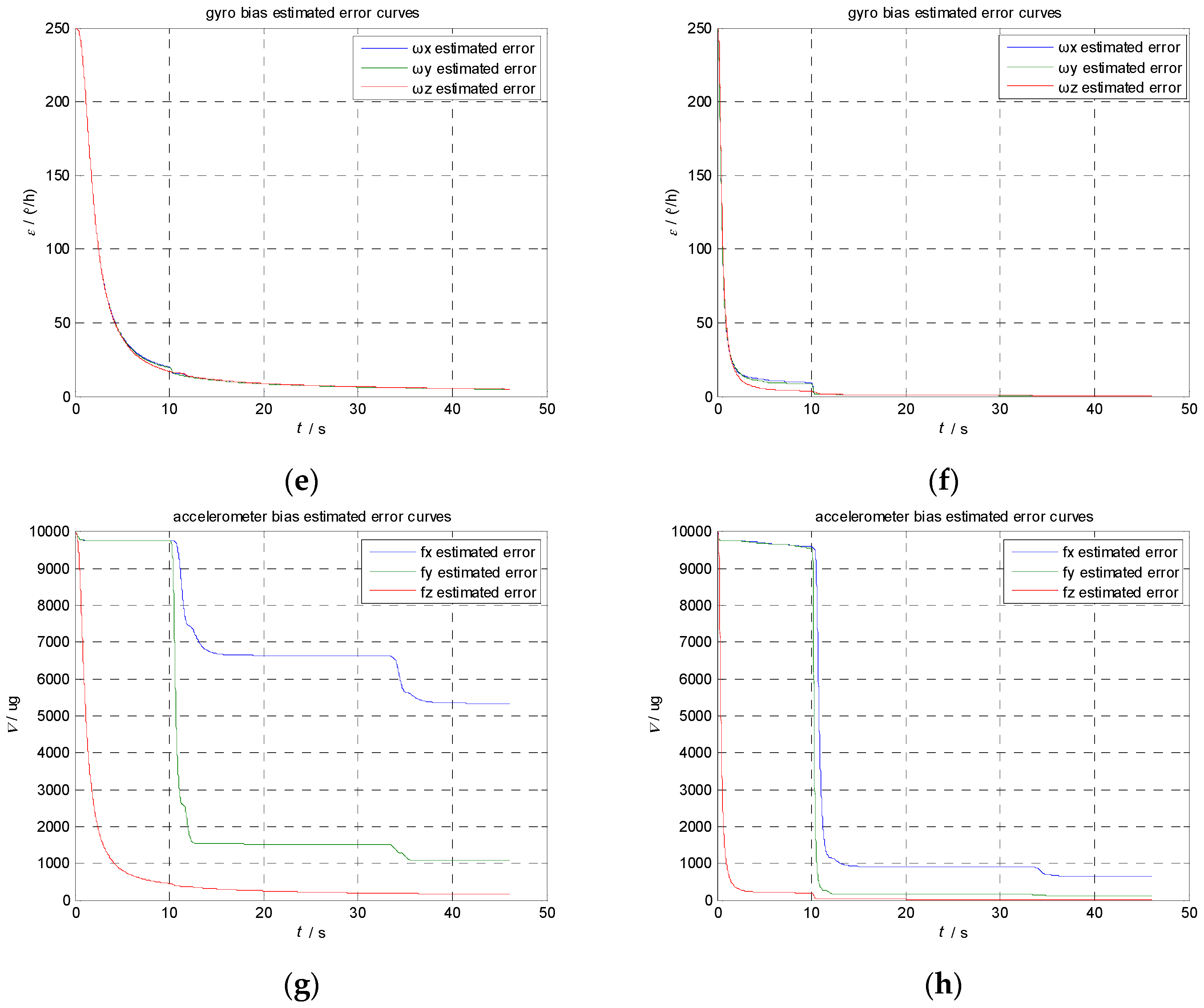
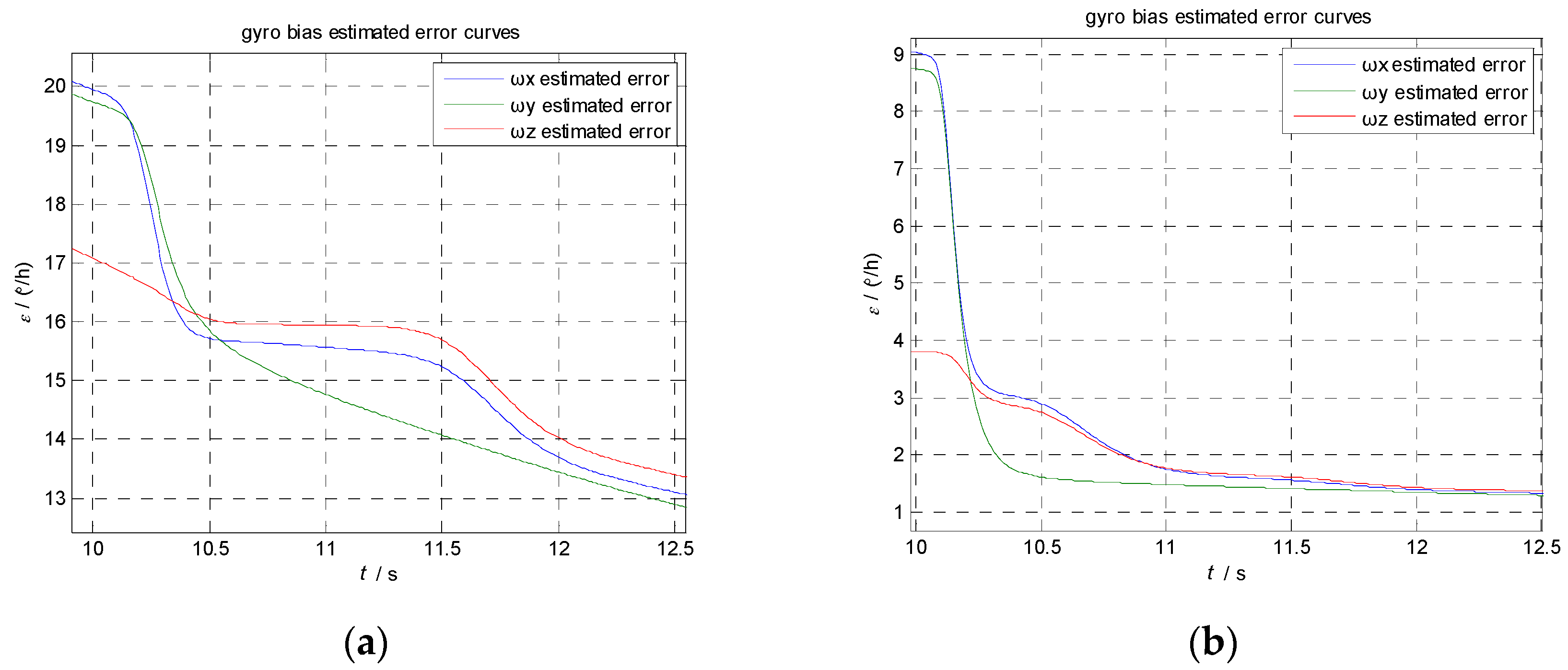
| AIKF | AKF | KF | ||
|---|---|---|---|---|
| Noise estimator | 2n2 + 3n | 2n2 + 3n | - | |
| 2n2 + m2 + 2nm2 − nm + 2n2m + 4n3 | 4n3 + 2n2m + 2n2 + 3mn − n | - | ||
| 4mn + 3m | 2mn + 3m | - | ||
| 12mn2 + 8m2n + 3m2 − 6mn | 4m2 + 2mn2 + 2m2n − mn | - | ||
| Prediction update | 2n2 | 2n2 | 2n2 | |
| Pk,k−1 | 4n3 − n2 | 4n3 − n2 | 4n3−n2 | |
| Measurement update | 10mn + 2m − n | 4mn + m | nm + n + m | |
| Pk | 8mn2 + 6m2n-m2 − 4mn | 4mn2 + 4m2n − 2mn | 2mn2 + 2n3 − n2 | |
| Kk | 4n2m + 2n3 + 2nm2 − n2 − 2nm + m3 | 2mn2 + 2m2n − 2mn + m3 | 4n2m + 4nm2 − 3nm + m3 | |
| In total | 4n2 + 2n + 10n3 + 5m + 3m2 + 18nm2 + nm + 26n2m + m3 | 8n3 + 10n2m + 5n2 + 4mn + 2n + 4m + 4m2 + 8m2n + m3 | 6n3 + 6mn2 + 4nm2 − 2nm + m3 + m + n | |
| n = 21, m= 6 | 177,300 | 109,731 | 74,457 | |
| Gyro | Accelerometer | |
|---|---|---|
| Bias drift | 250 °/h | 10 mg |
| Noise | 0.5 °/ | 1 mg/ |
| Algorithm | Estimation Error of Gyroscope Bias/(°/h) | Estimation Error of Accelerometer Bias/(mg) | ||||
|---|---|---|---|---|---|---|
| x-Axis | y-Axis | z-Axis | x-Axis | y-Axis | z-Axis | |
| KF | 6.94 | 6.71 | 7.00 | 6.18 | 1.36 | 0.21 |
| AIKF | 0.81 | 0.81 | 0.73 | 0.81 | 0.14 | 0.02 |
| Algorithm | Estimation Error of Attitude Error/(′) | Estimation Error of Velocity Error /(m/s) | ||||
|---|---|---|---|---|---|---|
| x-Axis | Y-Axis | z-Axis | x-Axis | y-Axis | z-Axis | |
| KF | 10.42 | 18.81 | 4.77 | 0.0151 | 0.0151 | 0.0147 |
| AIKF | 1.33 | 2.46 | 0.48 | 0.0016 | 0.0015 | 0.0015 |
© 2017 by the authors; licensee MDPI, Basel, Switzerland. This article is an open access article distributed under the terms and conditions of the Creative Commons Attribution (CC-BY) license (http://creativecommons.org/licenses/by/4.0/).
Share and Cite
Chu, H.; Sun, T.; Zhang, B.; Zhang, H.; Chen, Y. Rapid Transfer Alignment of MEMS SINS Based on Adaptive Incremental Kalman Filter. Sensors 2017, 17, 152. https://doi.org/10.3390/s17010152
Chu H, Sun T, Zhang B, Zhang H, Chen Y. Rapid Transfer Alignment of MEMS SINS Based on Adaptive Incremental Kalman Filter. Sensors. 2017; 17(1):152. https://doi.org/10.3390/s17010152
Chicago/Turabian StyleChu, Hairong, Tingting Sun, Baiqiang Zhang, Hongwei Zhang, and Yang Chen. 2017. "Rapid Transfer Alignment of MEMS SINS Based on Adaptive Incremental Kalman Filter" Sensors 17, no. 1: 152. https://doi.org/10.3390/s17010152






